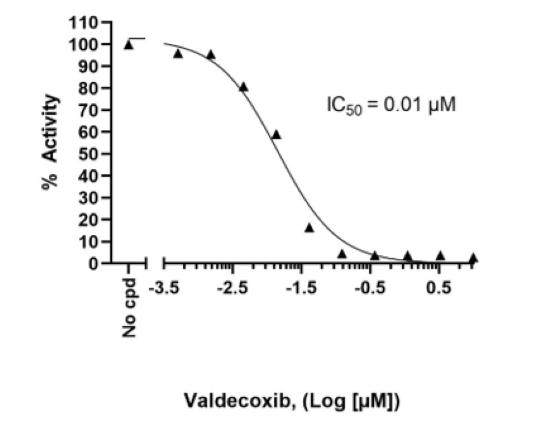COX2 Inhibitor Screening Assay Kit
The COX2 Inhibitor Screening Assay Kit is designed to measure COX2 (cyclooxygenase 2) activity for screening and profiling applications. The assay kit comes in a convenient 96-well format, with enough purified recombinant COX2, Amplex™ Red, Arachidonic Diluent, COX Assay Buffer, and 100% ethanol for 100 enzyme reactions.
- Arachidonic Acid (Cayman Chemical #90010.1)
- Adjustable micropipettor and sterile tips
- Fluorescence plate reader capable of measurement at λex535/λem590 nm
| Catalog # | Name | Amount | Storage |
| 71111 | COX2, FLAG-His-Tags* | 35 µg | -80°C |
| Amplex™ Red | 100 µl | -80°C | |
| Arachidonic Diluent | 250 µl | -80°C | |
| COX Assay Buffer | 10 ml | -80°C | |
| 100% Ethanol | 1 ml | -80°C | |
| 79685 | 96-well black microplate | 1 | Room Temp |
* The concentration of protein is lot-specific and will be indicated on the tube containing the protein.
COX2 (cyclooxygenase 2), also known as prostaglandin-endoperoxide synthase (PTGS), is a peroxidase involved in the formation of prostaglandin during inflammation. COX2 converts arachidonic acid to prostaglandin H2. COX1 and COX2 differ in position 523, with COX2 having a valine and COX1 an isoleucine residue, making the development of specific inhibitors a challenge. While COX1 is expressed constitutively in most cells, COX2 is expressed in response to pro-inflammatory signals. Prostaglandins are involved in inflammation and pain, and the use of COX inhibitors or NSAIDs (non-steroidal anti-inflammatory drugs) is common to manage these symptoms. Classical NSAIDs, such as aspirin and ibuprofen, are not COX2 specific and can result in damage to the gastrointestinal system. Recently the focus has been on developing selective inhibitors, such as celecoxib and etoricoxib, which can result in less stomach ulceration. These, however, can cause heart failure and other cardiovascular abnormalities. In the central nervous system COX2 is found in normal conditions and contributes to synaptic activity and other brain related activities, and COX2 inhibition may prevent brain inflammation and neurodegeneration. COX2 is also upregulated in cancers, such as breast, lung, colon, cervical and pancreatic cancer. Prostaglandin H2 can be converted into PGE2 (prostaglandin E2), that can result in increased VEGF (vascular endothelial growth factor) levels, expression of BCL2 (B cell lymphoma 2), and activation of other signaling pathways involved in cancer progression. An understanding of the role of COX2 and mode of action of its inhibitors can result in optimized therapies for COX2 related pathologies.
Minghetti L., 2004 J Neuropathol Exp Neurol 63(9): 901-10.
Giovannini M., et al., 2003 Int J Immunopathol Pharmacol 16(2):31-40.
Pang L., et al., 2016 Stem Cells Int 2016:2048731


